- Talkback is an accessibility feature meant for visually impaired people.
- You can enable TalkBack on Android from Settings > Accessibility > TalkBack and tap the toggle next to it.
Talkback is a part of the accessibility suite on Android devices. It makes smartphone navigation convenient for visually impaired people. It provides spoken feedback and audible cues to help navigate and interact with the phone. In this quick tutorial, we will guide you step-by-step on how to turn on TalkBack on Android from device Settings and using ADB.
When enabled, TalkBack reads out loud text, menus, and other screen elements. This feature can be enabled from the Accessibility menu on Android devices.
3 Ways to Turn on Talkback
1. From Device Settings
Turning on TalkBack on an Android device through the Settings menu is much easier than turning it off.
- Open the Settings app on your Android device.
- Scroll down to find Accessibility. If you own a OnePlus phone, you’ll find Accessibility under Settings > System. On Xiaomi and Redmi phones, navigate to Settings > Additional settings. The easiest way to find any item under device settings is to tap the Search icon or the Search bar and type your query word.
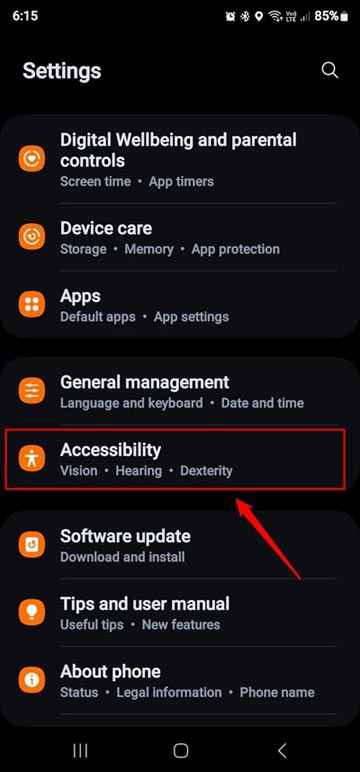
- Tap Accessibility, and you should find TalkBack and other accessibility options on the next screen. Tap on TalkBack.
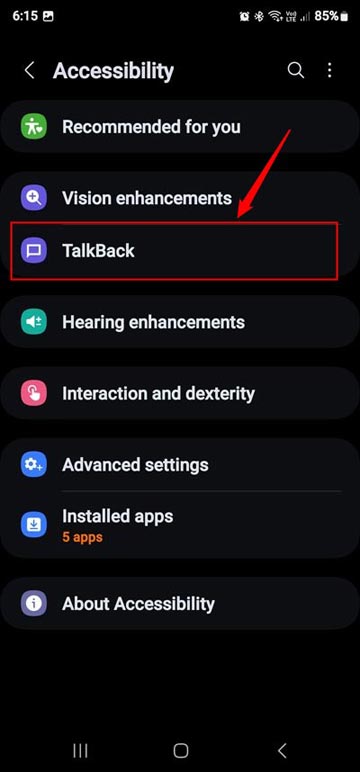
- Tap the toggle button next to the TalkBack option.
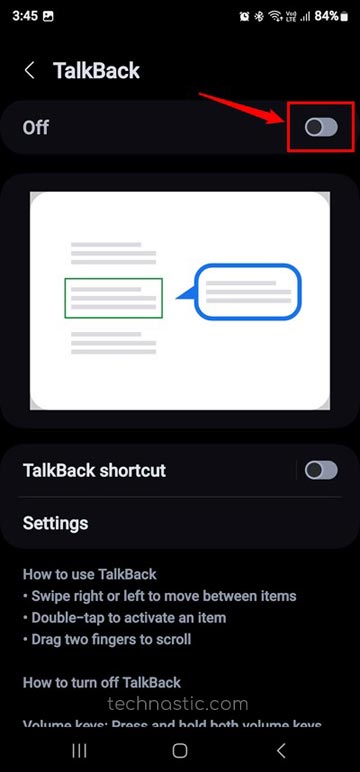
- Your Android device will prompt you to grant full Accessibility permissions to TalkBack so that it can control your phone. Tap Allow when prompted.
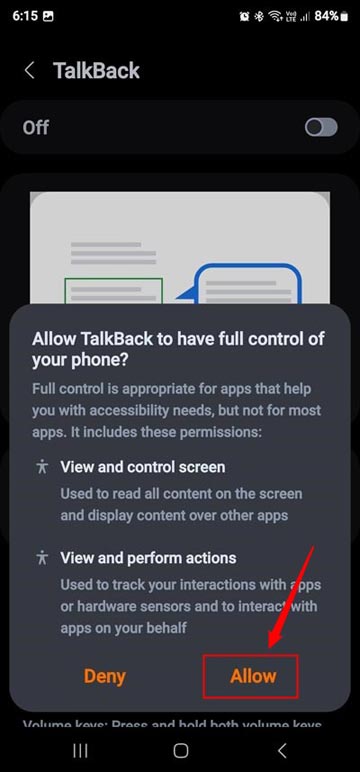
- You’ll then be prompted to change language settings if you want to. Select OK.

- Finally, tap Turn off when prompted.
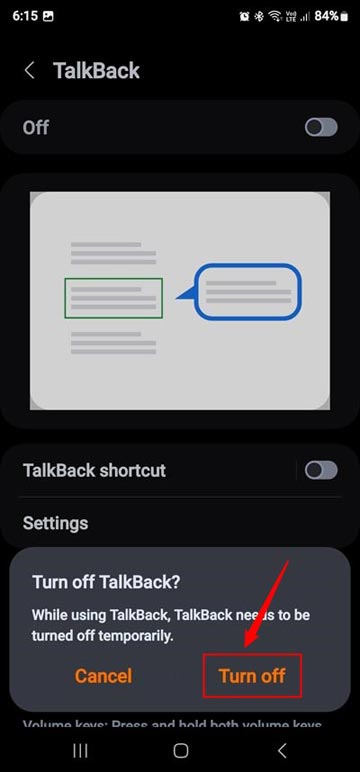
TalkBack will turn on your Android phone. You’ll start getting audio feedback.
2. Via TalkBack Shortcuts
Android devices let you create TalkBack shortcuts to enable or disable this accessibility feature. Here is how to create TalkBack shortcuts on an Android phone or tablet.
- Navigate to Settings > Accessibility > TalkBack and tap the toggle button next to the TalkBack shortcut option to enable it.
- Now tap the TalkBack shortcut to view the shortcuts.
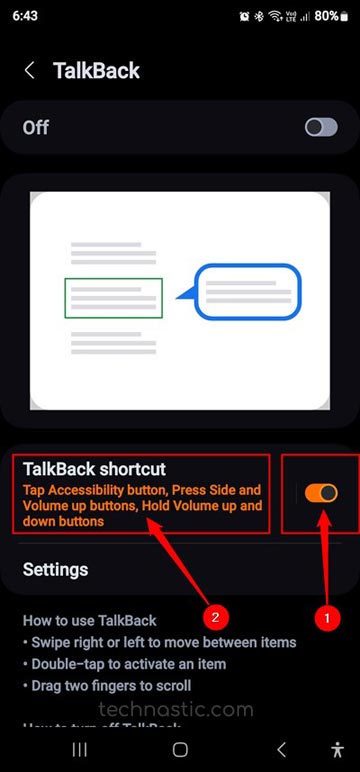
- On the next page, you’ll have the list of Talkback shortcuts you can enable.

As you can see, there are 3 ways to turn TalkBack on or off using shortcuts.
- Tap the Accessibility button on the navigation bar.
- Press the Power + Volume up buttons simultaneously.
- Press and hold the Volume up + Volume down buttons together for 3 seconds.
3. Using an ADB Command
You can also turn on TalkBack on your Android phone or tablet with ADB. If you have already set up ADB on your Windows, macOS, or Linux system, you may jump to the command execution steps directly. However, if you are new to ADB, you must set it up.
- Download and install the latest ADB and Fastboot drivers.
- Extract the downloaded Zip and move the ‘platform-tools’ folder to a convenient location on your computer.
- Enable USB debugging from the Developer options on your Android device.
- Also, navigate to Settings > Display > Screen timeout and extend it to 10 minutes. Later, you can revert to your preferred screen time-out duration.
- Connect your phone to your computer using a compatible USB cable.
- Now, open the extracted Platform-tools folder.
- Type ‘powershell‘ in the folder window address bar to launch a PowerShell window. Alternatively, place the mouse pointer in an empty place in the folder window, right-click on the mouse, and select Open in Terminal from the context menu.
- When the PowerShell window is launched, type the following command and hit Enter. Check your phone’s screen and tap Allow when prompted to authorize ADB on your device.
adb devices
- ADB will show your device ID represented by a string of alphanumeric values. It shows that your device is connected and ready to accept commands from your computer.

- Now, execute the following command in the PowerShell window.
adb shell settings put secure enabled_accessibility_services com.google.android.marvin.talkback/com.google.android.marvin.talkback.TalkBackService
You have successfully enabled TalkBack using ADB. You should also check out these ADB commands to control Accessibility settings on your Android device.
Talkback Touch Gestures
Now that you have enabled TalkBack on your device, you must use touch gestures to navigate, select, input text, and activate or deactivate the on-screen options or items. Below is a list of gestures that will help you control your phone and use it in TalkBack mode.
- Single tap: Tap with one finger to select an app, option, or on-screen item. The selected item is highlighted with an outline. When the keyboard app is active, you can type text using the single tap gesture.
- Double-tap: Tap with one finger twice to open an app or select an on-screen item. When an audio or video app is running. You can stop, play, or pause it by double-tapping anywhere on the screen.
- Swipe from right to left: Swipe with one finger from right to left on your phone’s screen to move up in a list of options.
- Swipe from left to right: To move down, swipe with one finger from the left side of your device’s screen to the right. You can use swiping with two fingers to clear the notifications.
- Swipe up and down: Swipe up and down with two fingers to scroll up or down.
- Swipe up: Swipe with two fingers from the bottom of the home screen to open the app drawer.
- Swipe down: Swipe down with two fingers from the status bar to open the notification shade and quick settings screen.
- Triple tap: To hear status bar info like the time, date, battery level, signal strength, etc., use the triple-tap gesture anywhere on the screen with 2 fingers.

